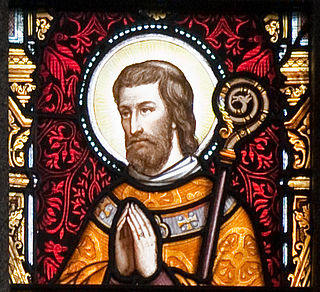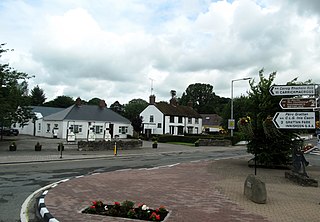Biography
Daig was born in Kiennacta Breagh, County Meath. His father was Carill, son of Laisrén, son of Dallán, son of Eógan mac Néill, son of Niall of the Nine Hostages, son of Eochaid Mugmedón.
Daig's mother's name was Dediva (also called Editua or Dedi or Deidi or Deighe or Deidiu or Deaga or Mediva), daughter of Tren, son of Dubhthach moccu Lughair, who was Chief Ollam of Ireland and royal poet of King Lóegaire mac Néill. Dediva's other children were Saint Senan of Laraghabrine, son of Fintan, Saint Diarmaid the Just, son of Lugna, Saint Caillin, son of Niata, Saint Felim of Kilmore, who was another son of Carill and Daig's older brother, Saint Femia, who was another daughter of Carill, St. Mainchín of Corann, son of Collan of Corann and Senchán Torpéist, another Chief Ollam of Ireland.
When a boy he went to the monastery of Devenish Island, County Fermanagh to study under Saint Laisrén mac Nad Froích. After finishing his studies there he went to study under Saint Comgall of Bangor monastery. When he graduated he worked as an artisan for Saint Ciarán of Saigir for whom he made 300 bells, 300 croziers and 300 Gospels which were distributed as gifts to other monasteries in Ireland.
He then founded his monastery at Inniskeen, County Monaghan. Saint Columba blessed it for him. Locals tried to kill him but failed and were expelled to the Beara Peninsula, County Cork. Saint Berach was one of his disciples. Daig performed many miracles which are enumerated in his Life. The Félire Óengusso ("Martyrology of Óengus"), states "A man of grace for our wheat was Daig, the good and great son of Cairell". He was present at the death of Carláen the bishop of Armagh who died on 24 March 588. Daige died shortly afterwards on 18 August in the same year and his feastday is celebrated on that date.
Saint Daig is mentioned in the Codex Salmanticensis (Brussels, Royal Library 7672–4) which is a medieval Irish manuscript containing an extensive collection of Irish saints' Lives.

Saint Molaiseof Leighlin, also Laisrén or Laserian, was an early Irish saint and abbot of Lethglenn or Leithglenn, now Old Leighlin in County Carlow, who is supposed to have lived in the 6th and 7th centuries.

Saint Máedóc of Ferns, also known as Saint Aidan, Saint Madoc or Saint Mogue, was an Irish saint who was the first Bishop of Ferns in County Wexford and the founder of thirty churches. His birth name was Áed, the name of the Irish god of the underworld, meaning "fire". The name Aidan is a diminutive form of Aed or Aodh, and was also a form of the Latin name Dominus. Máedóc and Mogue are other pet forms of Aed or Aodh, formed from the Irish affectionate prefix mo- and the diminutive suffix -óg, meaning "young", making for something like "my dear little Aodh".
Áed mac Néill, commonly called Áed Oirdnide, was King of Ailech. A member of the Cenél nEógain dynasty of the northern Uí Néill, he was the son of Niall Frossach. Like his father, Áed was reckoned High King of Ireland. He was King of Ailech from 788 onwards and High King of Ireland from 797.
Saint Felim, an Irish Christian hermit and priest, was born, probably in Kiennacta Breagh, County Meath in the mid sixth century.
Eochaid mac Colla, better known as Saint Dallán or Dallán Forgaill, was an early Christian Irish poet and saint known as the writer of the "Amra Coluim Chille" and, traditionally, "Rop Tú Mo Baile".
Heber MacMahon was bishop of Clogher and general in Ulster. He was educated at the Irish college, Douay, and at Louvain, and ordained a Roman Catholic priest 1625. He became bishop of Clogher in 1643 and a leader among the confederate Catholics. As a general of the Ulster army, he fought Oliver Cromwell at the Battle of Scarrifholis in 1650. He was defeated, taken prisoner and executed the same year.
Saint Diarmaid the Just was a Catholic abbot of Inis Clothrann (Inchcleraun), Lough Ree, County Longford and of Faughalstown, County Westmeath and a famous Irish confessor of the late-sixth century.

Inniskeen, officially Inishkeen, is a small village, townland and parish in County Monaghan, Ireland, close to the County Louth and County Armagh borders. The village is located about 17 kilometres (11 mi) from Dundalk, 11 km (7 mi) from Carrickmacross, and 5 km (3 mi) from Crossmaglen. Seven townlands of this Roman Catholic Diocese of Clogher parish lie within County Louth.
Events from the 7th century in Ireland.
Events from the 6th century in Ireland.
Events from the 5th century in Ireland.
Events from the 11th century in Ireland.

Áed mac Bricc was an Irish bishop and saint.
Senchán Torpéist was a Gaelic-Irish poet.
Dubthach maccu Lugair, is a legendary Irish poet and lawyer who supposedly lived at the time of St Patrick's mission in Ireland and in the reign of Lóegaire mac Néill, high-king of Ireland, to which Dubthach served as Chief Poet and Brehon. In contrast to the king and his druids, he is said to have readily accepted the new religion. This event has played a major part in Hiberno-Latin and Irish sources as representing the integration of native Irish learning with the Christian faith.
Saint Caillin was an Irish medieval saint and monastic founder. His Feast day is celebrated on 13 November. The patron saint of Fenagh, County Leitrim, Caillin was born in the 6th century and founded a monastic settlement at Fenagh. His history was given in the Old Book of Fenagh. The Annals of the Four Masters mention of him living in 464 is based on the very late unreliable 16th century Book of Fenagh. All his siblings lived in the second half of the 6th century so it is likely Caillín lived at the same time. This date is also supported by his position in the Irish genealogies and by the Life of Saint Mogue, who was taught by Caillín.
Mainchín mac Colláin was an Irish saint in Corran who is supposed to have flourished in the late 5th or 6th century.
Saint Senan of Laraghbrine, County Kildare, was an Irish Christian monk who lived towards the end of the 6th century. His father was Fintan, son of Strened, son of Glinder, son of Corc, son of Conned, son of Aengus, son of Fieg, son of Mail, son of Carthage of the race of Eochaidh.
Saint Femia was an Irish Christian saint, a sister of Saint Felim of Kilmore and Saint Daig of Inniskeen.
Saint Carláen was the Bishop of Armagh, Ireland from 578 to 588.



